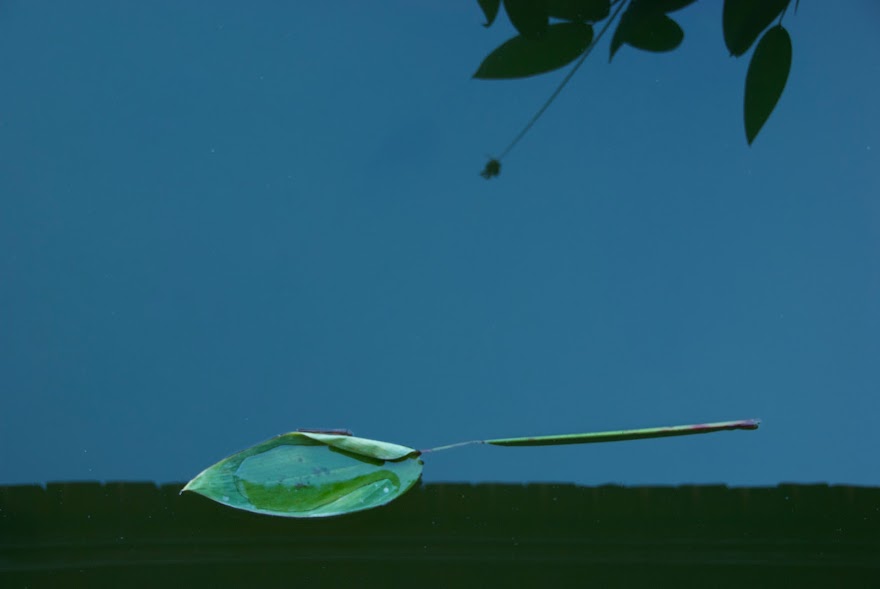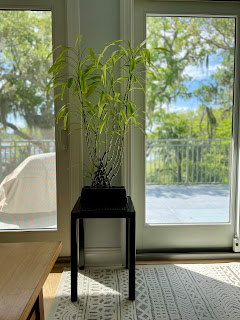I am sitting on the screened porch Wednesday morning sipping coffee. Sunny. Calm. Skull Creek glassy. 70F/21C. Lovely. An about 40’ sloop is powering north past the marina. Probably a snowbirder heading back after a winter in Florida.
Here is ‘No Where In Particular’, the only article I wrote for publication last year. It appeared a couple of months ago in SAIL. That version was somewhat edited. Here it is as I originally wrote it.
I woke at 5:30 Friday morning to the sound of rain on the deck. I was on the port pipe berth of my Moore 24, GANNET. GANNET was anchored in 60’ of water thirteen miles off South Carolina’s Hilton Head Island where I live.
We had anchored under a full moon in dying wind at 9:30 the previous night. My ePropulsion electric outboard does not have thirteen mile range and we weren’t going to get into Port Royal Sound at the north end of the island unless I was willing to stay awake all night, which I wasn’t. The barometer was high, the sky clear. I judged correctly that nothing serious would happen that night and so dropped the ten pound Spade over the bow. All chain rodes are best, but ultralight GANNET cannot carry that weight. Only the first 20’ of her rode is ¼” chain, the rest is ½“ braided nylon which enables me to anchor the little boat in deeper water than I have preferred, in the past.
I slept relatively well. We rolled for a while on a low swell, then the ocean went flat, then we begin rolling again the last hour or two before I fully woke.
I untied the lee cloth and climbed from the pipe berth. I had slept fully dressed in case something happened. I turned on one of my solar lights and put on my foul weather gear and removed the companionway slat.
I was beyond cell phone coverage, but I could get NOAA weather on my handheld VHF and learned that there was a small craft advisory for 20-25 knot winds and 5’ waves. Under sail such conditions might be an inconvenience, but anchored thirteen miles offshore with no protection they were serious.
In pre-dawn darkness I put on my headlamp and made my way to the foredeck. I took a brush and bucket with a line attached and dipped it over the side for water, then sat down and began to haul in the 150’ of rode I had out. This took a while, bringing in 10’ at a time, then holding the rode with my right hand while I flaked the line into its deployment bag with my left, but finally it was done. The anchor came up clean as it always has around Hilton Head.
Anchor and deployment bag dropped through the forward hatch onto the v-berth, I went aft, unfurled the jib, set the tiller pilot, and we began to sail almost silently toward the buoy two miles away marking the outer end of the channel into Port Royal Sound.
I had pushed GANNET from her slip at 1:00 PM the preceding Saturday. Headed by a light northwest wind, we powered slowly around the long curve of Skull Creek, which is part of the IntraCoastal, 1.8 miles to Port Royal Sound, where I cut the outboard and we sailed under jib alone until 3:00 when I anchored.
The ePropulsion is my third electric outboard. My first two were Torqeedos. I changed because of the possibility of greater range. The ePropulsion has a bigger battery and what is called hydrogeneration. Leave the prop spinning in the water while sailing and at about 4 knots it starts recharging the battery. I was concerned about the noise this might make, but the prop is remarkably quiet. However it is also remarkably slow, increasing the charge at only about 1% per hour. The prospect of dragging a prop for several hundred miles did not appeal, so after anchoring I removed the outboard and bracket from the stern and took the battery down below to charge off the ship’s batteries, and then went back up on deck to listen to some music and enjoy a drink and a spectacular sunset.
I had a quiet night, woke at first light, and had the anchor up at 8. As the anchor came off the bottom the outgoing tide turned GANNET’s bow and I had only to unfurl the jib and engage the tiller pilot for us to be making five tide assisted knots down the sound. Soon with an increase of the wind to 18 knots on the beam, we were making 8 knots. On a relatively cool 51º morning for South Carolina, I was wearing Levis and a Polartec.
We were heading offshore with no destination.
The plan was to put the wind on or aft of the beam and have several days of good sailing no matter our course, then turn and work our way back. That’s not what happened, but it was the plan.
GANNET only draws 4’1”, but shoals that can be a concern even for her extend a long way offshore from Hilton Head Island, so we sailed not far outside the buoys marking the channel for almost two hours as the wind backed and increased to twenty knots. The waves increased too as we moved away from the land and began to slam into our port quarter. Concerned that they might drown the tiller pilot, I partially furled the jib and set up the port running backstay.
You have to go a long way out to get clear of this part of the coast.
An hour later we passed through a line of five ships anchored waiting to enter Savannah Harbor. Still beyond them were scattered buoys, some marking fishing havens, some belonging to the Navy, and eight isolated Navy towers, some as much as fifty miles offshore, but we were clear enough so that I was able to go below, move the anchor and rode bag to the bow and rearrange other stowage.
Before leaving the slip I had reconfigured the interior into sailing mode. In harbor mode I sleep on the starboard side of the v-berth. In sailing mode, the v-berth is used for stowage and I sleep on whichever is the windward pipe berth.
Wind and waves increased throughout what became a rough, hang on day. More and more slammed into and over us. They were only 5’ or 6’, but they were steep and close together. Wind against Gulf Stream.
In late afternoon GANNET was drawn toward one of the Navy towers as if to a magnet. I had to disengage the tiller pilot and hand steer to get us around it.
We were rolling so much that I spilled water pouring it into the JetBoil to heat for freeze dry chicken and dumplings. A gin and tonic spilled before I had my first sip. And a wave came down below to add salt to my meal, my Levis, and a glass of boxed red wine.
Then at 8:00 the wind abruptly died and we rolled becalmed through a miserable night. For a while the jib collapsed and filled fifteen or twenty times a minute, so I furled it and let us drift. I was up many times looking for a nearby Navy tower and did not get much sleep. This was not the vision I had.
Dawn found us drifting north at one knot. At 8:00 a light wind filled in from the north, so I unfurled the jib and raised the main and GANNET began to make three knots southeast.
At noon I routinely record our position, day’s run, and barometric pressure. At noon that day we were 42 miles from our noon position the day before, but there was no point in considering a day’s run because we had changed course so often, southeast, south, west, north, east and now southeast again.
I had fit a new stern light that morning. My masthead tricolor/anchor light has stopped operating, and though I like living on Hilton Head Island very much—our condo looks out on serenity and beauty: live oaks and Spanish moss; Palmetto palms; spartina; the marina where I can see GANNET’s mast five hundred feet away; the changing light on Skull Creek—it is the most difficult place I have ever kept a boat on which to get work done, so I was using the deck nav lights and found the stern light too bright, ruining my night vision whenever I stuck my head out. I fit a seemingly well made multi-purpose NaviSafe light, which can be configured as an anchor light, a steaming light, or a stern light. It fits into GoPro mounts, of which I have many. I tried attaching one to the deck near the stern with its own adhesive, which did not hold adequately, so I SuperGlued it and attached a cord to the light in case it came free.
By midafternoon I passed the last Navy buoy and was more than fifty miles offshore and seemed to have the ocean to myself. I have written about entering the monastery of the sea. I hadn’t, but I felt a sense of space and openness and simplicity that I never do on land.
With GANNET sailing smoothly on a beam reach at six knots I was able to spend time on deck. Sunset found me sipping an air temperature gin and tonic and listening to music. This was the vision I had. It lasted too briefly.
We sailed well until 4 A.M. when I woke because GANNET was moving too fast for the tiller pilot to keep up. We were making 9 knots. GANNET can do more if I want to hand steer. I didn’t and stood in the companionway and deeply furled the jib.
After that I did not expect I would fall back to sleep, but I did, finally waking for good at 6:30.
Another rough, rolly day of GANNET following 20+ knot veering wind across a dark blue white-capped ocean beneath a hazy blue sky.
I spent most of the day below deck, reading at what is called Central, sitting on a Sport-a-Seat on the cabin sole, facing aft from the main bulkhead, rising from time to time to check and change course.
That evening I found myself wondering if sailing to no where can be enough. If I stayed out a month would that be enough? Enough for what? I did not know. But I knew there is an 81 year old man who is still wondering what he ought to do, what he wants to do, rather than merely wait for time and chance to end him. And I knew that it was good to be out there. Just me and GANNET and the ocean. I was where I wanted to be.
The next morning, Wednesday, the wind decided that I had been there long enough by continuing to veer until it was south of east. If we continued reaching we would close the coast of Florida. I did not want to do that. Instead I gybed and we turned back a day early toward Port Royal Sound 160 miles away.
From below, looking out the main hatch, I could see the ocean streaming past, sometimes blue, sometimes foaming white. It looked as it had hundreds of times during GANNET’s circumnavigation, but I knew it wasn’t, and somehow that mattered.
Just before sunset I went on deck to turn on the stern light. A wave came. GANNET lurched. I got a gash on my head from the backstay and my leg from the cockpit coaming. I already had a gash on my left arm and two more on my head. I need a carbon fiber skull cap. Sailing GANNET there will be blood.
We re-entered the Gulf Stream Thursday.
Checking our GPS position in the iSailor app I found our COG was 30º to 40º north of our compass heading. I set course farther off the wind to compensate. I did not want to end up off Charleston and have to beat back.
By noon we were no longer being set north and the wind eased. Under full main and jib we had fine sailing, making an easy 6 and 7 knots. I sat on deck and listened to music, No drink for me that evening other than a 0% alcohol Heineken.
At sunset the lights of seven anchored ships were ahead of us. As we passed between them I considered the men on board them and how different their experience of the ocean is from mine.
In diminishing wind GANNET gradually slowed and at 9:30 I anchored.
The sky was solid low overcast in shades of gray and black.
A few minutes after the outer buoy marking the entrance channel came into view, another line of rain reached us and the wind continued to veer.
We crossed the channel and set our course just outside the line of green buoys. Although GANNET was dashing along at 8 and 9 knots and the slip was only seventeen miles away I was not certain we would get in that day. The little boat is light and underpowered and easily moved by wind and tide. I wanted a hot shower and later a cold drink, but if the wind went much above 20 knots, I would not approach the marina. We would anchor in Port Royal Sound until the front passed.
The channel doglegs to the northwest as it enters the sound. The water smoothed as we made that turn.
Half way up the sound I lowered the main. Our speed only dropped to 7 knots.
The ePropulsion should have a range of more than seven miles, but I have found that sometimes it doesn’t, so we sailed until the green marker at the mouth of Skull Creek was abeam before I furled the jib and turned on the outboard.
There is an inverse ratio of speed to range with an electric outboard. We had the first third of the outgoing tide and wind varying from 20 to 8 knots against us in the creek. I tried to maintain an SOG of 2 knots, but saw speeds of less than 1 to more than 3. I frequently leaned back to check the diminishing battery level.
As we reached the apex of the curve in the creek I could set a course directly for the marina a half mile ahead. With the outboard battery at 59% I knew we were going to make it and put out fenders and dock lines. Until then there was always the possibility that we would have to anchor and recharge the battery.
The rain had paused while we were powering up the creek, but a dark line of clouds over Pickney Island to the west promised it would soon resume. Two hundred yards from the marina I removed my foul weather gear and sea boots and put on boat shoes to be able to move more easily when I docked. I hoped the rain would hold off for ten minutes. In now more than eighty years I have come to understand that my hopes have no standing in the universe. Just as I made the turn into A Dock heavy rain began to fall. The air temperature was in the mid-60s, but it made me cold and worse made it difficult to see.
I most feel the Skull Creek tides in docking GANNET. I like to dock at bare steerage way. Yet slow too much and the tide and wind move the boat in undesired directions.
We docked.
I got the dock lines in place and retired to what I call The Great Cabin. On GANNET the distance between floorboards and overhead is 38”.
I sat at Central, listening to the rain patter on the deck. I sipped bottled ice tea. I made a FaceTime call to Carol. I checked the barometer and found it had fallen 13 millibars in 14 hours. That is a quick and deep fall. I was surprised the weather was not more extreme.
I considered the sail. We had covered almost five hundred miles. For a few moments I wondered if sailing without a destination had been a good idea and then I realized that it was. We did not find the sailing I had hoped for, but in several years on this coast I have learned that here the wind comes from any direction and any strength and the only constant is change. A sailor knows that whatever wind he has will not last. Still old boats and old sailors need to be used and for a while GANNET and I were again together in our element.
I am pelagic. I like to set out and not turn back. Since the end of my sixth circumnavigation I have felt as though I am on a tether.
One evening during the first passage of GANNET’s circumnavigation, between San Diego and Hilo, Hawaii, I stood in the companionway as the little sloop ran west before the trades and thought, ‘Use yourself up old man. Use yourself up.’
That was nine years and more than 30,000 sea miles ago. Yet at 81 I feel I am not yet Aused up. Perhaps I deceive myself, but I think I can still do more.
When in an hour the rain eased, I walked home.














